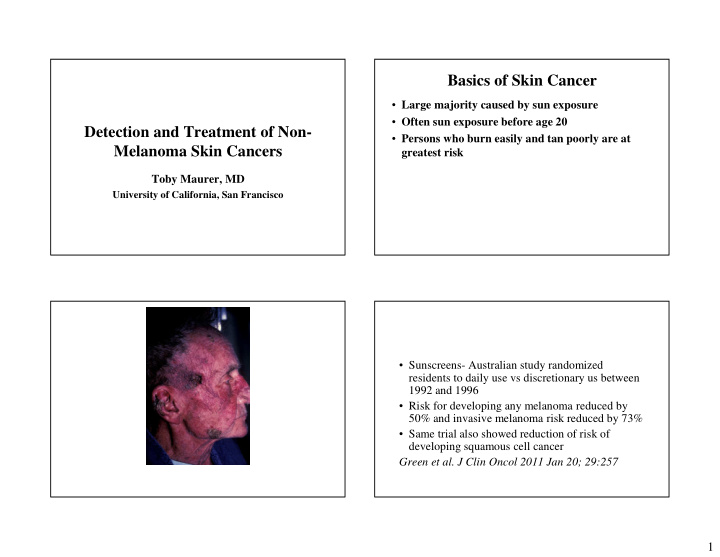



Basics of Skin Cancer • Large majority caused by sun exposure • Often sun exposure before age 20 Detection and Treatment of Non- • Persons who burn easily and tan poorly are at Melanoma Skin Cancers greatest risk Toby Maurer, MD University of California, San Francisco • Sunscreens- Australian study randomized residents to daily use vs discretionary us between 1992 and 1996 • Risk for developing any melanoma reduced by 50% and invasive melanoma risk reduced by 73% • Same trial also showed reduction of risk of developing squamous cell cancer Green et al. J Clin Oncol 2011 Jan 20; 29:257 1
Vit D controversy • Intermittant weekly UVB exposure is most convenient source of vit D. • Sun exposure causes cancer • Supplement Vit D with food/vitamins until more is known Tanning Beds “I’m Here for a Skin Check” • Screening for skin cancer: an update from US • International Agency for Research on Cancer preventive services task force: Annals of • Comprehensive metaanlaysis found that risk of Internal Med 2009 Feb-Wolff T, et al. melanoma (skin and eye) increases by 75% when • Can screening by Primary MD reduce tanning begins before age 30. morbidity/mortality from skin cancer? • Cite this to your young patients • Hard to do study-need to follow 800,000 El Ghissassi et al. Lancet Oncol 2009 Aug 10:751 persons over long period of time to determine this-studies not done 2
Non-Melanoma Skin Cancers Bottom line: • Not enough evidence for or against to advise • Basal cell carcinoma (BCC) that patients have routine full body exams • Actinic keratosis (AK) BUT • Squamous cell carcinoma (SCC) • Know risk factors and incorporate exam into Keratoacanthomas full physical and teach patients what to look for Basal Cell Carcinoma (BCC) • Who is at Risk? – Age 20+ – Fair-skinned persons – Sun-exposed sites • over 50% on face 3
4
Diagnosis of BCC: Shave or Punch Biopsy 5
Differential Diagnosis of BCC • Intradermal Nevus • Sebaceous hypersplasia • Fibrous Papule (angiofibroma) • Eczema • Melanoma 6
7
8
Recommended Treatment of BCC • Surgical excision (head and neck) • Curettage and desiccation (trunk) • Radiation therapy (debilitated patient) • Microscopically controlled surgery (Mohs) – Recurrent/sclerotic BCC’s – BCC’s on eyelid and nasal tip Treatments NOT Recommended Aldara (Imiquimod) • Topical therapy designed for wart treatment • Cryotherapy • Upregulates interferon/ down regulates tumor • Topical chemotherapy necrosis factor/works on toll like receptors - 5 Fleurourical (Efudex) • Seems to have efficacy in superficial BCC’s • Radiation therapy (good surgical candidate) • Do Not use in BCC’s that are nodular or invasive • Biopsy to confirm diagnosis BEFORE treatment 9
When to Refer Actinic Keratosis (AK) • It depends on your surgical skills • Who is at risk? – Over age 35-40 • > 1 cm – Fair-skinned persons • Sclerotic BCC – Sun-exposed sites • Recurrent BCC • Face, forearms, hands, upper trunk • Eyelid BCC – History of chronic sun exposure Clinical Features of AK • Red, adherent, scaly lesions, usually < 5mm • Sandpapery, rough texture • Tender when touched or shaved • Thick, warty character (cutaneous horn) 10
Diagnosis of AK • Diagnosis – Clinical features – Shave or punch biopsy • Differential Diagnosis – BCC/SCC – Seborrheic keratosis – Wart 11
Treatment of AK • Cryotherapy-goal is 2x15 sec thaws • Topical chemotherapy/chemical peel – Efudex (5FU crème) 2x’s/day x 6 wks or Imiquimod- 3X’s /wk and 3 mos. 12
Photodynamic therapy • Place photosensitizer on skin and then use light therapy-increases absorbency of light • Evidence that it changes histologic features of photodamage and changes expression of oncogenes Uses in: • Actinic keratoses • Basal cell cancers • Superiority studies being evaluated • Bagazgoitia et al BJD 2011 July Squamous Cell Carcinoma (SCC) Clinical Features of SCC • Who is at risk? • Papule, nodule or tumor – Age 50+ • Non-healing erosion or ulcer – Chronic sun exposure • Cutaneous horn (wart-like lesion) • Head, neck, lower lip, ears, dorsal hands, trunk • Fixed, red, scaling patch/plaque (Bowen’s- – Special circumstances SCC-in-situ) • Immunosuppression (organ transplant) • Radiation therapy 13
14
15
Differential Diagnosis of SCC • Actinic keratosis • Wart • Seborrheic keratosis • BCC • Eczema or psoriasis 16
How to Diagnose • Punch or excisional/incisional biopsy • Shave biopsy for flat, non-elevated lesion 17
Treatment of SCC When to Refer • Recommended treatment • SCC’s may metastasize – Excision • Low threshold for biopsy and referral – Radiation therapy ( in debilitated patient) • Regularly check draining lymph nodes • Treatments NOT recommended • High risk SCC’s – Curettage and desiccation – Topical chemotherapy High-risk SCC’s • Lip • Temple • Immunocompromised host (i.e. organ transplant)- 65x increased risk of SCC’s) • Area of previous radiation therapy 18
Keratoacanthomas • What are they?-self-healing SCC’s • Look like SCC’s but history is that they come up quickly • Biopsy to rule out SCC • Sometimes pathologist cannot tell the difference • Treat by injecting methotrexate, 5 FU-but close follow-up to make sure that tumor regression is evident-if not, excise like SCC 19
Recommend
More recommend